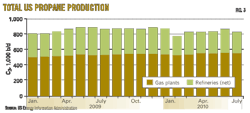Global ethylene producers add record capacity in 2010
Warren R. True
Chief Technology Editor—LNG/Gas Processing
Global ethylene producers last year added more than 8.6 million tonnes/year (tpy) of capacity, according to the latest Oil & Gas Journal's survey of the industry. That level sets a record for 1-year additions.
New capacities at three Middle East plants reached 3.95 million tpy, while start-ups at five plants in Asia-Pacific made up the rest with 4.7 million tpy.
The figure for 2010 exceeded capacity added in 2009 (OGJ, July 26, 2010, p. 34) and the record addition in 2008 of 7 million tpy (OGJ, July 27, 2009, p. 49). Including estimates for 2011, these 4 years evince the recent rapid growth of Asian and Middle Eastern ethylene capacity. By contrast, capacity growth in 2007 was 2 million tpy and only 245,000 tpy in 2006.
Global ethylene production capacity at Jan. 1, 2011, net of additions and closings, was more than 138 million tpy, compared with nearly 130 million tpy for 2009, 126.7 million tpy in 2008, and 119.6 million tpy in the survey for 2007 (OGJ, July 28, 2008, p. 46). The additional capacity in 2010 represents a net increase of 6%.
The survey lists eight new worldscale ethylene plants with combined production capacity of 8.65 million tpy, which started up in 2010.
Fig. 1 shows growth since 2007. Capacities continued the trend set in 2008 of capacity additions racing ahead since the lowest capacity-addition rate in at least 20 years in 2006.
For 2011, more than 4.8 million tpy are slated to start up, a slackening in the pace of growth for the first time in 5 years. In 2010, OGJ had estimated last year that more than 11 million tpy of capacity would start up during last year, but survey results found less than that amount actually came on line in the calendar year, a record nonetheless.
New units
In April 2010, China Petroleum and Chemical Corp. (Sinopec) began operations of its 1-million-tpy ethylene plant in Zhenhai. Last August, Sinopec announced that its ethylene joint venture with Saudi Basic Industries Corp. in Tianjin in northern China had begun full operations with total production capacity of 1.2 million tpy.
The project took a total investment of $2.7 billion, reported the Xinhua News Agency. The joint-venture company Sinopec SABIC Tianjin Petrochemical Co. is in charge of operation and management.
Total ethylene production capacity last year in China advanced by 2.2 million tpy.
As stated in last year's report, Shell Eastern Petroleum Ltd. started up in April its 800,000-tpy ethylene cracker in Singapore (OGJ Online, Apr. 19, 2010). The cracker complex is part of the Shell Eastern Petrochemicals Complex, which consists of modifications to the existing Bukom refinery and construction of a new worldscale monoethylene glycol plant on Jurong island.
In Thailand, the joint venture of Siam Cement PLC and Dow Chemical Co. started up a 900,000-tpy ethylene plant at the Map Ta Phut olefins plant.
Total Asia-Pacific start-up ethylene capacity in 2010 reached 4.7 million tpy.
The other additions to global ethylene capacity were in the Middle East.
In April 2010, Eastern Petrochemical Co. in joint venture with Saudi Basic Industries Corp. and SPDC Ltd. began operating its 1.3-million-tpy plant at Jubail, Saudi Arabia.
In mid-2010, Saudi Kayan Petrochemicals Co., started operations at its petrochemicals complex's main units at Al Jubail. Kayan, a unit of Saudi Basic Industries Corp., earlier in the year had started up the complex's main 1.35-million-tpy ethylene unit with other units to follow through in 2012.
The complex will be able to produce as much as 6 million tpy of ethylene, propylene, and ethylene glycol from 16 plants.
The addition brought ethylene capacity in the country to 11.9 million tpy, third largest country capacity in the world behind the US and China.
Finally, in May 2010, partners in Ras Laffan Olefins Co. started up the 1.3-million-tpy ethylene unit at Ras Laffan Industrial City, north of Qatar's capital Doha.
RLOC is a Qatari company, owned by Q-Chem II (53.31%), Qatofin Co. Ltd. (45.69%), and Qatar Petroleum (1%). The ethylene unit is operated by Q-Chem II, a joint venture between QP and a subsidiary of Chevron Phillips Chemical Co.
Ethylene produced by RLOC moves from Ras Laffan to Q-Chem II and Qatofin derivatives units in Mesaieed, south of Doha, via an 84-mile pipeline. In Mesaieed, 700,000 tpy of ethylene is allocated to Q-Chem II; 600,000 tpy to Qatofin, said the companies.
Total start-up ethylene capacity in the Middle East in 2010 reached 3.95 million tpy.
Table 1 shows rankings of the 10 largest ethylene production complexes in the world. The order for 2010 remains unchanged, according to OGJ survey data, with only ChevronPhillips Chemical Co.'s Sweeny, Tex., plant showing a slight increase to 1,865,000.
Regional review
Table 2 ranks ethylene production capacity by region; Table 3 shows changes for individual countries between 2009 and 2010.
What happened to one leading country in 2011, however, will likely roil the list for 2011 data.
In mid-2010, Japan's government revealed that the country's ethylene production had risen 7.2% in July from July 2009 as a result of fewer maintenance shutdowns. This point marked the first year-over-year rise since March 2010.
Japanese ethylene plants produced 593,700 tonnes, compared with 553,800 tonnes for July 2009 and up by 16.7% from 508,800 tonnes in June 2010.
OGJ figures for yearend 2010 show Japan ethylene production capacity at nearly 7.3 million tpy, second only to Chinese capacity in the Asia-Pacific region and fourth overall in the world.
But the massive earthquake off Japan's northeast coast in March 2011 and the resulting tsunami knocked out about 25% of its ethylene production capacity, the Japan Times reported. In one instance, Mitsubishi Chemical Corp. was forced to halt operations altogether at its ethylene plant at Kashima City in Ibaraki Prefecture. OGJ data show its two units with combined capacity of 828,000 tpy.
In another, Maruzen Petrochemical Co.'s ethylene plant in Chiba Prefecture was shut down due to quake damage with some doubts it would be able to restart without a source for naphtha feedstock, as the plant had been obtaining it from nearby Cosmo Oil Co. oil plant, which also reported damage.
Largest ethylene producers
Table 4 lists the top 10 owners of ethylene capacity worldwide. The first column of capacities presents them for assets owned entirely by one company; the second column reflects the total of actual percentages for companies in joint ownership.
Construction
Table 5 lists ethylene production capacity slated to start up during 2011-13. Fig. 2 presents a long-term view of global capacity growth.
In late 2010, PetroChina Co. Ltd. announced it would complete expansion of its unit at Daqing by June 2012, doubling the plant's ethylene capacity to 1.2 million tpy. This will be about a year later than earlier planned. PetroChina began expanding the plant in northeast China in September 2009.
In India late last year, GAIL (India) Ltd. selected the Shaw Group Inc. to provide its proprietary technology and basic engineering for a new 450,000-tpy ethylene plant as part of GAIL's petrochemical complex in Pata, Uttar Pradesh. Shaw also is providing support during detailed engineering, procurement and construction, and commissioning and start-up of the plant.
In mid-2010, Bloomberg reported that South Korea's Honam Petrochemical Corp. would buy Malaysia's Titan Chemicals Corp. in a deal valued at $1.25 billion. South Korea's second-largest ethylene maker agreed to acquire a 37.3% stake in Titan from Chao Group and a 35.3% interest from Permodalan National Bhd.
Upon the deal's closing later in the year, Honam's capacity to produce ethylene rose to 2.47 million tpy from 1.75 million tpy, the company said. Titan was Malaysia's biggest producer of olefins and polyolefins and reported sales of $1.64 billion in 2009, said the media report.
Also last year, Russian chemical group Sibur announced plans to build at Tobolsk, western Siberia, a gas pyrolysis cracker to produce more than 1 million tpy ethylene. Feedstock will be mixed NGLs.
Sibur Pres. Dmitry Konov was reported to have said the project, if approved, would be operating by 2015-16.
Total Petrochemicals in late 2010 was talking to Qatar about developing a $6 billion petrochemical plant. Discussions were about plans for another mixed-feedstock cracker in Ras Laffan.
Qapco operates a 720,000-tpy polyethylene plant in Mesaieed industrial city and the Ras Laffan ethane cracker, which opened in April 2010 and is a joint venture between Q-Chem and Qatofin, as described earlier.
Earlier in 2011, Qatar Petrochemical Co. Ltd. hired the Shaw Group Inc. to provide basic engineering for the expansion of a 720,000-tpy ethylene plant in Mesaieed. The project will provide the design needed for expanding the plant's capacity by up to 25%.
In North Africa recently, Sidi Kerir Petrochemicals Co., Alexandria, announced that it and two Egyptian government companies are investing about $1.18 billion in an ethylene venture. Sidi Kerir already had a license to build a plant capable of producing 460,000 tpy of ethylene and will own 20% of the new company.
Due to be completed in 3 years, the project will be financed by local banks, including National Bank of Egypt, Banque Misr SAE, Commercial International Bank SAE, National Societe Generale Bank SAE, and Arab African Bank, according to the oil ministry's web site.
North America
In the US last month, Shell announced preliminary plans to build a large ethylene plant in Appalachia based on ethane from natural gas produced from the Marcellus shale (OGJ Online, June 6, 2011).
The company didn't identify a site for the plant, which would include production of derivatives yet to be determined. "The leading option is polyethylene," Shell said in a news release. The release treated the plans as indefinite and didn't report capacity. But, it described the prospective ethane cracker as "world scale."
Shell entered the Marcellus shale play in 2010 by buying privately owned East Resources of Warrendale, Pa., for $4.7 billion (OGJ, June 7, 2010, Newsletter).
OGJ data show that Shell operates US ethylene capacities at Deer Park, Tex., of 1.18 million tpy and at Norco, La., of 1.45 million tpy.
Liquids from parts of the Marcellus play have spawned a number of schemes, mostly takeaway pipelines, to monetize their production, as there is little fractionation within convenient reach of producing areas.
In April this year, Dow Chemical announced plans to increase its ethylene and propylene production and integrate its US operations into feedstock available from increasing supplies of US shale gas in the Marcellus and Eagle Ford (Tex.) shales.
In order to increase its ethylene supply and ethane cracking capabilities at existing US Gulf Coast plants, the company will restart an ethylene unit at its St. Charles operation near Hahnville, La., by yearend 2012. Dow will also improve ethane feedstock flexibility for an ethylene unit at its plant in Plaquemine, La., in 2014.
This announcement furthered plans the company announced at yearend 2010 to increase ethane cracking capabilities on the US Gulf Coast over the next 2-3 years and improve its ethane cracking capabilities by 20-30% over the same period.
In addition, Dow said it was reviewing joint-venture options for building an NGL fractionator to secure the supply of ethane.
In Canada in March of this year, Williams signed a long-term agreement to produce up to 17,000 b/d of ethane and ethylene for NOVA Chemicals Corp., in Alberta.
Williams will invest $311 million (Can.) to expand its two primary plants in Alberta to support the new agreement. The expansions, which will begin operating in first-quarter 2013, will allow the company to produce ethane and ethylene from its operations that process offgas from the Alberta oil sands.
The expansions involve modifying and upgrading two plants.
Williams will modify its oil sands off-gas extraction plant near Fort McMurray and construct a de-ethanizer at its Redwater NGL-olefins fractionator near Edmonton.
The upgrades at Fort McMurray will allow Williams to include ethane and ethylene in the NGL-olefins mix that the company extracts from the offgas and delivers to Redwater for fractionation.
The new de-ethanizer at Redwater will enable Williams to produce about 10,000 b/d initially of an ethane-ethylene mix, said the company. This will add to its current production of about 14,000 b/d of a heavier NGL-olefins mixture that includes propane, propylene, butane, butylenes, and condensate.
Under terms of the new agreement, Williams is to deliver the ethane-ethylene mix produced at Redwater into the Joffre feedstock pipeline. NOVA Chemicals delivers the product via this pipeline into its Joffre plant.
Williams is building a 261-mile, 12-in. NGL pipeline from its Fort McMurray extraction plant to its Redwater fractionator. The pipeline will have a capacity of 43,000 b/d of offgas NGL-olefins and will be in service by mid-2012. Installation of additional pump stations in the future would enable Williams to increase capacity on the pipeline to 125,000 b/d, said the company.
Also in March, Braskem-Idesa, the joint venture between the Brazilian Braskem and Mexican Group Idesa, has chosen Technip as technology provider for development of its 1-million-tpy ethylene unit based on ethane. This is part of the petrochemical complex to be built in Coatzacoalcos-Nanchital region, in the Mexican state of Veracruz, planned to be completed by yearend 2014.
The complex will also include one low-density polyethylene and two high-density polyethylene plants. Braskem-Idesa also selected Technip as contractor for the front end engineering design of the cracker and HDPE plants.
More Oil & Gas Journal Current Issue Articles
More Oil & Gas Journal Archives Issue Articles
View Oil and Gas Articles on PennEnergy.com






